Taking the first step with Semaglutide marks a meaningful commitment to improving your health and overall well-being. While the medication plays a vital role, the cornerstone of lasting success lies in a well-structured Semaglutide nutrition plan. We’ll walk you through the core principles of healthy eating that can complement and improve your treatment outcomes, ensuring you not only lose weight but also cultivate sustainable healthy habits for a healthier you.
Key Takeaways
- Prioritize lean protein sources in every meal to support muscle mass and promote satiety.
- Incorporate fiber-rich foods like vegetables, fruits, and whole grains to aid digestion and keep you feeling full.
- Focus on whole, minimally processed foods while limiting sugary snacks, fried foods, and sodas to minimize side effects and promote weight loss.
Understanding the Semaglutide Nutrition Plan for Weight Loss

When you’re looking into using semaglutide for weight loss, it’s not just about taking the medication. A big part of making it work well is what you eat. Think of it like this: semaglutide helps manage your appetite and how full you feel, but your food choices still matter a lot for your overall health and how much weight you lose. A good semaglutide meal plan is designed to work with the medication, not against it. It focuses on giving your body the nutrients it needs while helping you feel satisfied with smaller portions.
The goal is to build a sustainable eating routine that helps you stay consistent on your weight loss journey. This means focusing on foods that keep you full, provide steady energy, and minimize potential side effects. It’s about making smart choices that complement how semaglutide affects your body. For instance, the medication slows down how quickly your stomach empties, so eating heavy, fatty foods might lead to discomfort. Instead, a balanced semaglutide weight loss diet plan emphasizes lean proteins, plenty of vegetables, and whole grains.
Here’s a breakdown of what makes a good semaglutide meal plan for weight loss:
- Prioritize Protein: Protein helps you feel full longer and keeps your muscles strong while you lose weight. Aim for lean sources like chicken, fish, eggs, beans, and Greek yogurt at every meal.
- Load Up on Fiber: Fiber from vegetables, fruits, and whole grains aids digestion and also contributes to that feeling of fullness. Foods rich in healthy fats—like avocado, nuts, seeds, and olive oil—boost nutrient absorption and promote lasting fullness.
- Choose Complex Carbs: Trade refined sugars and white bread for healthier, fiber-packed grains like quinoa, oats, and brown rice. These provide sustained energy.
- Include Healthy Fats: Incorporating foods like avocado, nuts, seeds, and olive oil aids nutrient absorption and promotes a feeling of fullness.
It’s important to remember that while semaglutide can be a powerful tool, it works best when paired with mindful eating habits. Focusing on nutrient-dense foods helps your body respond better to the medication and supports overall well-being.
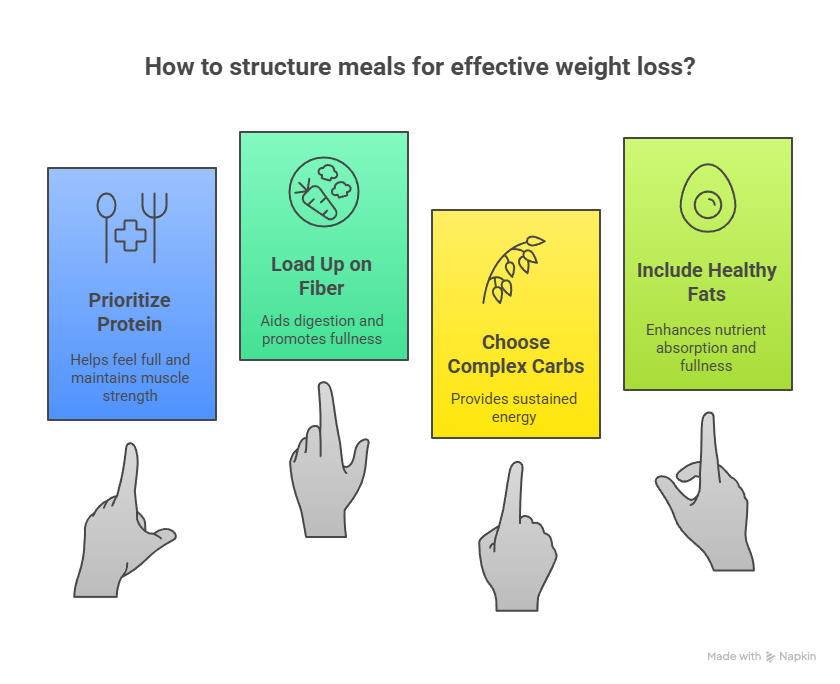
Building a solid semaglutide meal plan for weight loss is a key step in your journey. It’s about nourishing your body in a way that supports the medication’s effects and promotes lasting results. You can find more information on how these treatments work at Waters Edge Medical Clinic and Spa.
Building a Balanced Semaglutide Meal Plan for Lasting Results
Creating a meal plan that works with semaglutide is all about making smart choices that support your body and the medication’s effects. It’s not about deprivation, but rather about fueling yourself with foods that keep you feeling full, provide steady energy, and help manage any side effects. Think of it as giving your body the best possible support system.
The foundation of a good semaglutide meal plan rests on prioritizing lean proteins, fiber-rich foods, and healthy fats. These components work together to promote satiety, meaning you’ll feel fuller for longer, which naturally helps with reducing overall calorie intake. By stabilizing blood sugar levels, they help you maintain consistent energy and reduce the urge to snack.
Here’s a breakdown of what to focus on:
- Lean Proteins: These are your allies for muscle maintenance and feeling satisfied. Aim for sources like chicken breast, turkey, fish, eggs, Greek yogurt, tofu, and protein powders. Make sure each meal contains some form of protein to support your nutrition goals.
- Non-Starchy Vegetables: They’re packed with nutrients and help make your meals more filling without adding many calories. Load up on things like spinach, broccoli, cauliflower, bell peppers, zucchini, and leafy greens. They are packed with vitamins, minerals, and fiber.
- Whole Grains and Complex Carbohydrates: Replace refined grains with healthier choices like quinoa, oats, brown rice, and whole wheat bread. These provide sustained energy and more fiber, which aids digestion and keeps you feeling full.
- Healthy Fats: Don’t avoid healthy fats—foods like avocado, nuts, seeds, olive oil, and salmon support hormone balance and help you feel full. Just watch your portions, as they’re calorie-dense.
- Low-Sugar Fruits: Fruits are great for fiber and antioxidants, but it’s wise to stick to lower-sugar options like berries, apples, and citrus fruits. These are less likely to cause blood sugar spikes.
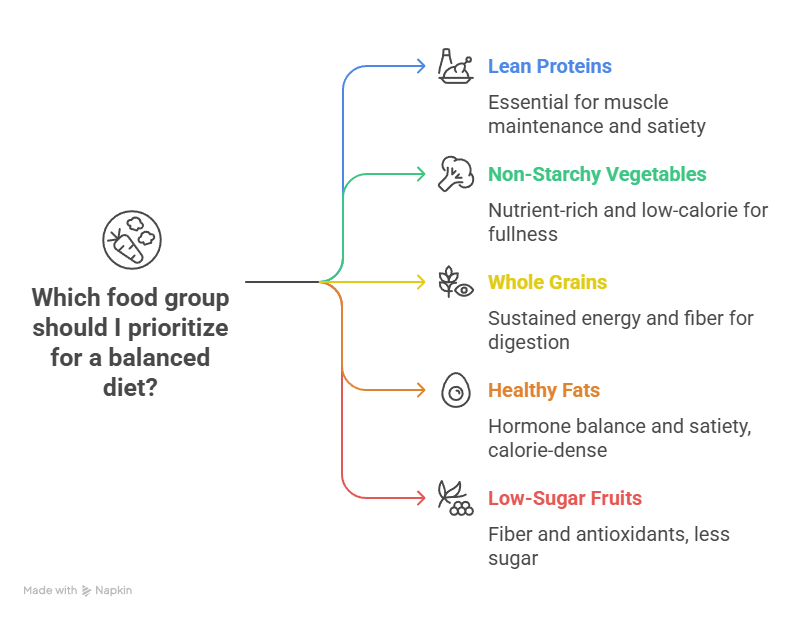
It’s essential to keep in mind that Semaglutide works best when supported by healthy, mindful eating. Focusing on nutrient-dense foods helps your body respond better to the medication and supports overall well-being.
Building a balanced meal plan isn’t about perfection, but consistency. Even minor, consistent improvements in your food choices can lead to noticeable benefits and better outcomes with Semaglutide.
How the Semaglutide Nutrition Plan Works Inside Your Body
When you start a semaglutide nutrition plan, it works alongside the medication to help you lose weight. Semaglutide itself is designed to mimic a natural hormone in your body, GLP-1. This hormone plays a big role in how you feel after eating and how your body processes food. By helping you feel fuller for longer and reducing your appetite, semaglutide makes it easier to eat less. This is where your nutrition plan really comes into play. It ensures that the food you do eat is packed with nutrients, which is important for keeping your energy up and your body functioning well as you lose weight.
Here’s a breakdown of what happens:
- Slower Stomach Emptying: Semaglutide helps slow down how quickly food leaves your stomach. This means you stay satisfied for a longer period after a meal, reducing the urge to snack between meals. Your nutrition plan should focus on foods that complement this, like those high in fiber and protein, which also contribute to fullness.
- Appetite Regulation: The medication signals to your brain that you are full. This helps curb cravings and reduces overall hunger.By keeping your blood sugar stable, a balanced diet provides consistent energy and reduces sudden hunger cravings.
- Metabolic Support: While semaglutide doesn’t directly speed up your metabolism in the way some other weight loss methods might, the weight loss it facilitates, combined with a nutrient-rich diet, supports a healthier metabolic state. This means your body can more efficiently use the energy it gets from food.
Regarding how is semaglutide metabolized, it’s processed by the body over time, with its effects lasting for about a week, which is why it’s typically administered weekly. The medication is broken down through normal metabolic processes, similar to other proteins. A well-designed nutrition plan provides your body with the vital nutrients necessary to support these functions and protect your health during weight loss. Opting for whole foods, lean proteins, and a variety of vegetables helps your body adapt smoothly to the changes.
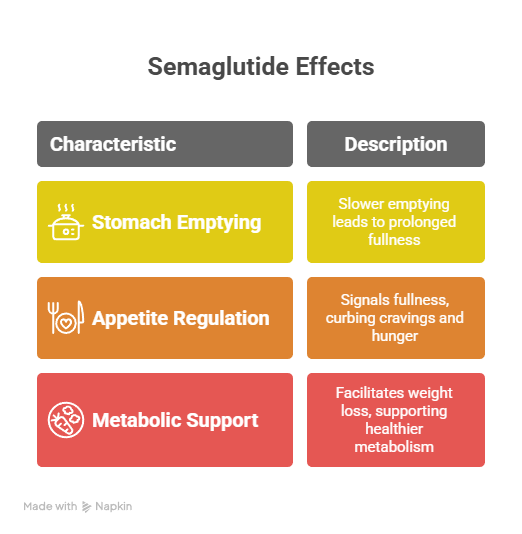
A well-structured nutrition plan is key to making the most of semaglutide.
It’s not just about eating less; it’s about eating smarter to support your body’s needs during this process. This approach helps you lose mostly fat while preserving muscle mass—essential for maintaining a healthy metabolism over time. Focusing on nutrient-dense foods also helps manage potential side effects like nausea, making the journey more comfortable. You can find helpful meal ideas to support your journey at MealPro’s semaglutide meal plans.
By understanding these mechanisms, you can better appreciate why the food choices you make are so important when using semaglutide for lasting results. It’s a partnership between the medication and your diet to achieve your weight loss goals.
What to Expect: Semaglutide Nutrition Plan and 4-Week Results
When beginning a Semaglutide nutrition plan, it’s normal to be curious about how quickly you’ll notice changes. People often observe a difference in how hungry they feel and how full they get within the first few weeks of using the medication. This initial phase is about getting your body accustomed to the new way of eating and the medication’s effects.
The first four weeks are often a period of adjustment and early progress. While significant, visible weight loss can take a bit longer, you might start to see some changes on the scale. It’s important to remember that semaglutide 4 week results are just the beginning of a longer journey. Think of it as laying the groundwork for sustainable changes.
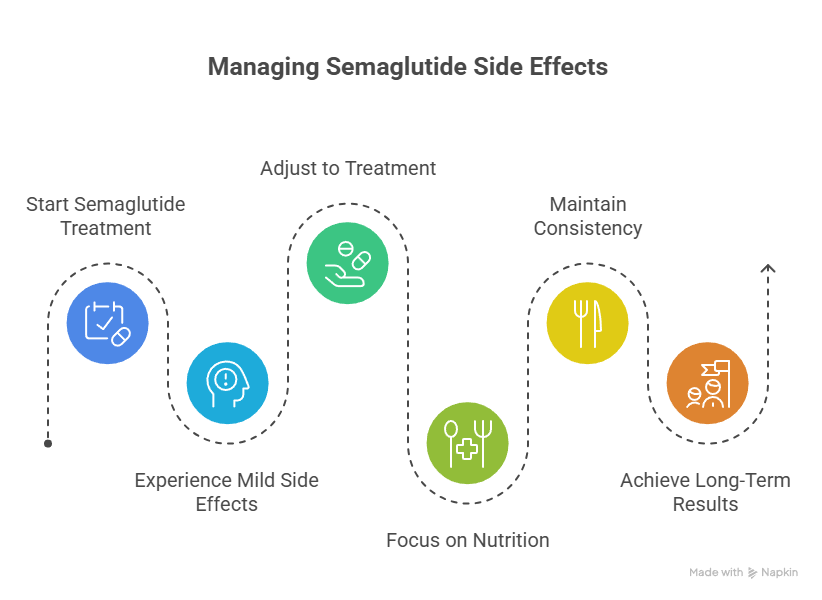
Here’s a general idea of what you might experience:
- Reduced Appetite: You’ll likely feel satisfied with smaller portions and experience fewer cravings.
- Increased Fullness: Meals will keep you feeling full for longer periods.
- Improved Food Choices: You might find yourself naturally drawn to more nutrient-dense foods.
- Early Weight Changes: Some individuals may see a few pounds come off, while others might see more substantial changes. This can depend on various factors, including your starting weight and how closely you adhere to the nutrition plan.
It’s also common to experience some mild side effects as your body adjusts. Things like slight nausea or changes in digestion can occur, but these often lessen over time. Focusing on the core principles of the nutrition plan, like prioritizing protein and fiber, can help manage these initial effects. Keep in mind that staying consistent with both your medication and healthy eating is crucial for long-term results. For more detailed information on the process and what to expect, you can look into the semaglutide treatment process.
The goal isn’t just rapid weight loss, but a shift towards healthier eating patterns that you can maintain long-term. This plan is designed to work with your body, not against it, making the process more manageable and effective over time.
Tips for Success: Maximizing Your Semaglutide Nutrition Plan
Sticking to a nutrition plan while on Semaglutide is key for getting the best results. It’s not just about taking the medication; what you eat really matters. Think of it as a partnership between the medication and your food choices to help you reach your weight loss goals.
Consistency is your best friend here. Small, sustainable changes to your eating habits are far more effective long-term than attempting a complete overhaul all at once. Focus on building a routine that feels manageable and enjoyable.
Here are some practical tips to help you succeed:
- Prioritize protein at every meal. Protein helps you feel full longer and is important for keeping your muscles strong as you lose weight. Good sources include lean meats, fish, eggs, Greek yogurt, and plant-based options like tofu and beans. Try to include roughly 20–30 grams of protein in each meal.
- Load up on fiber. Eating fiber-rich foods aids digestion and reduces hunger. Load half your plate with non-starchy veggies such as leafy greens, broccoli, and bell peppers. Whole grains, fruits, nuts, and seeds are also excellent fiber sources.
- Choose healthy fats. Healthy fats from avocado, olive oil, nuts, and fatty fish support hormone balance and help control appetite. Just be mindful of portion sizes.
- Stay hydrated. Drinking plenty of water throughout the day is vital. It can help manage hunger and prevent constipation, which is sometimes a side effect. Aim for at least 8 glasses of water daily.
- Limit processed foods and added sugars. These items often provide empty calories and can lead to energy crashes. Choose whole, minimally processed foods whenever you can, and use food labels to guide healthier choices.
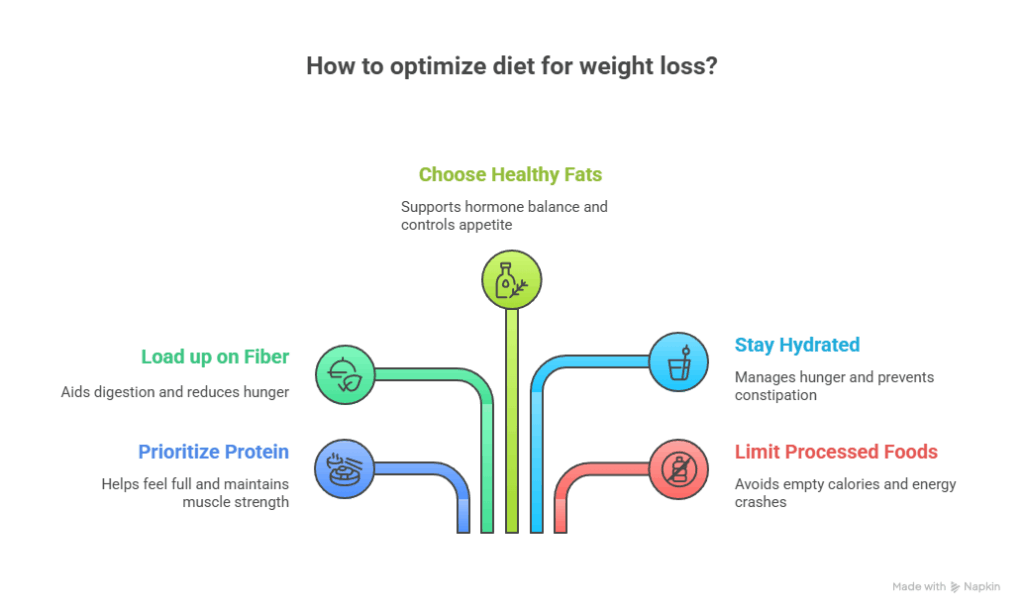
Listening to your body is essential—tune in to your hunger and fullness cues.
Eating slowly and mindfully helps you feel more satisfied after meals. This practice helps you avoid overeating and builds a healthier relationship with food.
Keep in mind that Semaglutide helps control appetite and slows stomach emptying to support better portion control. Your diet should complement these effects by providing nutrient-dense foods that keep you full and energized without overwhelming your system. This approach supports not only weight loss but also overall well-being.
Don’t forget to discuss your meal plan with your healthcare provider. They can help you tailor it to your specific needs and ensure you’re getting all the necessary nutrients. For example, some people find that incorporating specific injections, like B12, can support their energy levels during the weight loss process, which is something Water’s Edge offers.
By focusing on these strategies, you can make the most of your Semaglutide treatment and achieve lasting results.
Want to get the most out of your Semaglutide diet? Choosing the right foods can significantly improve both your energy levels and your overall results.Focus on lean proteins, lots of veggies, and healthy fats to keep your body happy and energized. Check out our website to discover the ways we can help you succeed!
Putting It All Together for Lasting Change
So, we’ve talked a lot about how Semaglutide can be a real help for weight loss. It’s not magic, though. The real trick to making the changes stick is what you eat. Focusing on protein, fiber, and good carbs, while cutting back on processed stuff and sugar, makes a big difference. Remember to listen to your body, too.
Everyone’s a bit different, so what works perfectly for one person might need a small tweak for another. If you’re feeling off, don’t be afraid to adjust your meals or talk to your doctor. Using Semaglutide with smart eating habits is the path to not just losing weight, but keeping it off and feeling better overall. It’s about building a healthier way of living, one meal at a time.
Frequently Asked Questions

What kinds of foods should I eat while on a Semaglutide nutrition plan?
Focus on eating foods that are good for you and won’t upset your stomach. This includes lean proteins like chicken or fish, lots of colorful vegetables, fruits like berries, and whole grains such as oats or quinoa. Good fats from avocados and nuts are an important part of a balanced diet.
Are there any foods I should avoid when following a Semaglutide plan?
It’s best to stay away from foods that are high in fat, fried, or packed with added sugars. Sugary drinks, like soda, and alcohol can also cause problems like bloating or make side effects worse. Consuming these foods may result in energy slumps and hinder your ability to reach your weight loss goals.
How long does it usually take to see results from the Semaglutide nutrition plan?
Many people start to notice changes, like feeling less hungry, within the first few weeks of starting the plan and taking the medication. Visible changes in weight often become apparent within one to two months. For the best and most lasting results, it typically takes about three to six months, especially when you combine the medication with healthy eating and lifestyle changes.
If you have any additional questions or if you would like to see if Semaglutide is right for you, contact us at Waters Edge Medical Clinic 727-550-0855.

